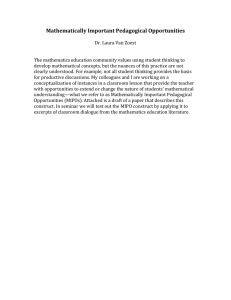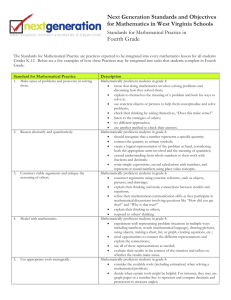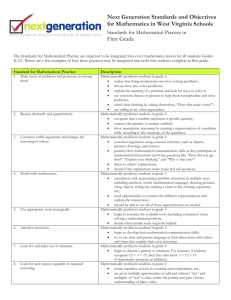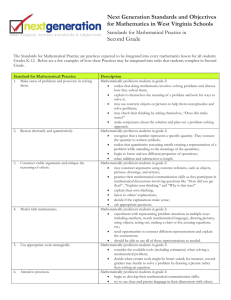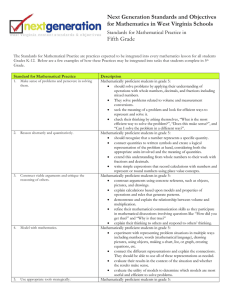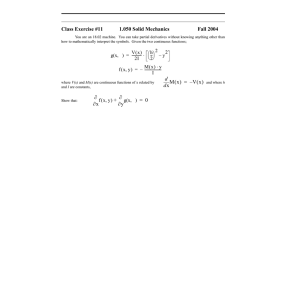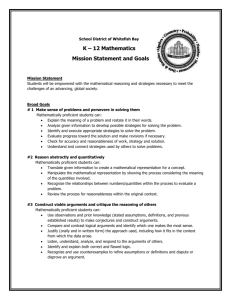Mathematical Practices and Indicators
advertisement
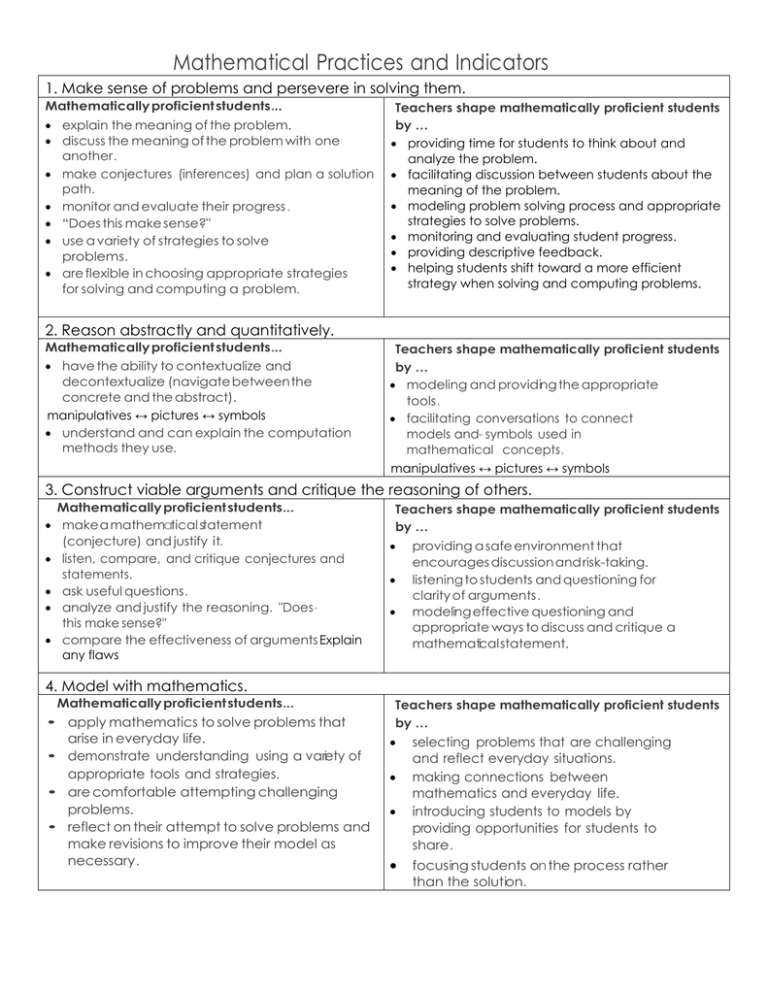
Mathematical Practices and Indicators 1. Make sense of problems and persevere in solving them. Mathematically proficient students ... explain the meaning of the problem. discuss the meaning of the problem with one another. make conjectures (inferences) and plan a solution path. monitor and evaluate their progress. “Does this make sense?" use a variety of strategies to solve problems. are flexible in choosing appropriate strategies for solving and computing a problem. Teachers shape mathematically proficient students by … providing time for students to think about and analyze the problem. facilitating discussion between students about the meaning of the problem. modeling problem solving process and appropriate strategies to solve problems. monitoring and evaluating student progress. providing descriptive feedback. helping students shift toward a more efficient strategy when solving and computing problems. 2. Reason abstractly and quantitatively. Mathematically proficient students ... have the ability to contextualize and decontextualize (navigate between the concrete and the abstract). manipulatives ↔ pictures ↔ symbols understand and can explain the computation methods they use. Teachers shape mathematically proficient students by … modeling and providing the appropriate tools. facilitating conversations to connect models and- symbols used in mathematical concepts. manipulatives ↔ pictures ↔ symbols 3. Construct viable arguments and critique the reasoning of others. Mathematically proficient students ... make a mathematical statement (conjecture) and justify it. listen, compare, and critique conjectures and statements. ask useful questions . analyze and justify the reasoning. "Doesthis make sense?" compare the effectiveness of arguments Explain any flaws Teachers shape mathematically proficient students by … providing a safe environment that encourages discussion and risk-taking. listening to students and questioning for clarity of arguments. modeling effective questioning and appropriate ways to discuss and critique a mathematical statement. 4. Model with mathematics. Mathematically proficient students ... • apply mathematics to solve problems that arise in everyday life. • demonstrate understanding using a variety of appropriate tools and strategies. • are comfortable attempting challenging problems. • reflect on their attempt to solve problems and make revisions to improve their model as necessary. Teachers shape mathematically proficient students by … selecting problems that are challenging and reflect everyday situations. making connections between mathematics and everyday life. introducing students to models by providing opportunities for students to share. focusing students on the process rather than the solution. 5. Use appropriate tools strategically. Mathematically proficient students ... • consider the available tools when solving a problem (i.e. calculator, protractor, ruler, manipulatives, software). • make sound decisions about tool selection. • detect possible errors when using tools by strategically using estimation and other mathematical knowledge. · • are able to use technological tools. Teachers shape mathematically proficient students by … • providing a variety of tools daily during mathematics instruction. • teaching and modeling appropriate use of tools. • facilitating discussion regarding tool selection. • modeling the use of technological tools to explore and deepen student understanding. 6. Attend to precision. Mathematically proficient students ... • use clear definitions and mathematical vocabulary to communicate reasoning. • specify labels, units, and answers within the context of the problem. • understand and explain the meaning of mathematical symbols. Teachers shape mathematically proficient students by … • providing content and academic word walls and anchor charts. • generating anchor charts with relevant student examples. • modeling and expecting the daily use of mathematical language and vocabulary. • modeling specific labels, units, and answers within the context of the problem. • providing opportunities for students to explore the mathematical symbols and their meaning 7. Look for and make use of structure. Mathematically proficient students ... • look closely to determine possible patterns and structure (properties) within a problem. • analyze patterns and apply them in appropriate mathematical context. • use prior knowledge of numbers and their relationships to reason and solve mathematical problems. Teachers shape mathematically proficient students by … • selecting problems that are challenging and incorporate the use of patterns. • building number sense daily. • facilitating the process of utilizing patterns and structure to compute and solve problems. 8. Look for and express regularity in repeated reasoning. Mathematically proficient students ... • notice repeating calculations and look for efficient methods/representations to solve a problem. • evaluate the reasonableness of their results throughout the problem solving process. Teachers shape mathematically proficient students by … • thinking-aloud the problem solving process by teachers and/or students. • providing students with time and opportunity to discover efficient methods for p roblem solving.
